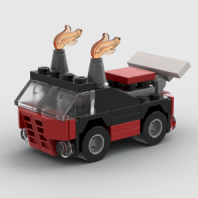Search the Community
Showing results for tags 'Power Functions'.
Found 368 results
-
Hello. Last weekend we had our major exhibition at the North of Portugal, PLUG Braga BRInCKa 2016. Me and my wife showed this LEGO aquarium, "As Sereias e a Cidade Perdida" ("The Mermaids and the Lost City"): Water (near 15l) of course, is not LEGO. All other parts are LEGO except some nuts I used: - 2 small M3 nuts inside the shell to force it to go down when air escapes (I'm also not sure if pneumatic tubes are LEGO or not, I got them at bricklink some time ago). Those 2 nuts could probably be replaced with LEGO magnets but I don't care much for purism. - near 140 M5 nuts inside the large green bricks at the bottom to increase weight and prevents all bricks from floating around (could use boat weight bricks, have enough for that but would take lots of space The air compressor is from Sariel - two pumps generate the curtain's bubbles, one pump is for the shell movement and the fourth pump is for the pyramid. There's also a Power Functions Light - one LED inside the pyramid and the other near the shell, behind the dolphin. The idea came after Paredes de Coura Fan Event, in June, where I attended Oton Ribic "Water" presentation. All those blue slopes came from Paredes de Coura and I had to do something with them. For the exhibition I used a few drops of a sodium hypochlorite solution to prevent algae and other micro-organisms to grow. So no real fish could be shown but I used a small Nemo electro-mechanical toy fish that swims a few seconds each time someone knocked the aquarium glass (sorry, forgot to record). A few more photos at flickr
- 7 replies
-
- water
- compressor
-
(and 1 more)
Tagged with:
-

MOD - 42024 Container Truck Full RC
Chilekesh posted a topic in LEGO Technic, Mindstorms, Model Team and Scale Modeling
Hi everyone, Here's my modification of Lego Technic 42024 Container Truck set. In addition to original functions (steering, outriggers and container lifting) it has: - 6x4 driving, - 90° tilting of the driver's cabin, - Working & tilting steering wheel, - Fake V8 engine (working), - Led lights, and is completely remote controlled. I used: - 1 L-motor for 6x4 driving - 1 Servo motor for steering - 1 M-motor for outriggers - 1 M-motor for lifting the container - 1 M-motor for tilting the cabin - 1 rechargeable battery box - 3 IR receivers - 1 set of led lights - 1 x 20 cm extension cable Bricksafe: http://bricksafe.com/pages/Chilekesh/42024-rc (*.lxf file can be found here). Rebrickable: http://rebrickable.com/mocs/Chilekesh/42024-container-truck-motorized-rc Any suggestions on improvements are very welcome. Cheers and happy building!- 3 replies
-
- remote controlled
- power functions
-
(and 5 more)
Tagged with:
-

Boxer's PF Electric System Upgrades
Boxerlego posted a topic in LEGO Technic, Mindstorms, Model Team and Scale Modeling
Hi, I'm going to be posting all my current electrical modifications for the PF system here and present everything like a guide manual and provide schematic, data sheets, and a parts list. I've been doing a lot of research on electronics lately and been making great progress on it all and decide to start posting what is going on here along with my successes and failures at developing this. I've been contemplatingseveral ideas as how to build this and will be going to demonstrate how to do several things such as convert the IR communication link to 433MHz RF and transmit a possible total of 4 channels out of one antenna and much more. This topic is not only about building off the existing Lego PF electric system, It will contain a basic understanding about the electrical components and look at all the different ideas that can be implemented as to how everything all works together from everything between the batteries to the motors to the controls. One of my main goals here is to up the scale at which models can be built and powered effectively by one or two motors. One of my longest going disputes is determining a proper battery pack to power my motors. From the very beginning my original idea was to have a 18v battery pack powering a 18v motor. However, awhile back I showed how to upgrade the XL motor with a motor that functions on voltages ranging from 8v up to 16v, so now I'm deciding between either using 12v or 15v battery pack to power the motor. Choosing a battery can be expensive and understanding the battery's voltage range is very critical for the circuit to work properly. There is a bunch of choices here as to what the battery powering the motors should be. I've been thinking on either using a Li-po battery or Li-ion or just continuing on using AA batteries. The next part of the circuit that is between the motor and the battery is the H bridge motor driver. This is the most critical aspect of the circuit as towards allowing the battery current to the motor and that current is dependent on several factors such as input voltage and temperature. There are several types of transistor out there and it is recommended to have a proper transistor in respect to the device you want to power. By looking at the data sheet it shows that the motor at maximum efficiency current 0.71a and the stall current 5.56a at 12v so here it can be establish that the transistor should be able to handle 10a if two of these motors were to stall simultaneously. The transistor I am using here are know as MOSFETs and the part number on the transistor is IRF540 and the the other one is IRF9540. That is my first H bridge I put together and there is definitely a range of improvements that can be done here. Now in order to power the H bridge to dive the motor is done by the 9v IR receiver motor connection. There are several ways I've gone about powering the 9v PF receiver from a higher voltage source such as 15v. In the picture below I use a voltage divider which is able to drop the voltage down to a usable voltage supply for the 9v receiver and the amount of current is drastically reduced to the 9v receiver, you will not be able to drive a micro motor with it but you will be able to power the H bridge, One of the main advantage here is using the high 9 volt supply out of the 9v receiver because the transistor is primarily a voltage driven device and that means more current for the motor. The main part of the upgrade is converting the IR signal to a RF signal. The remote control part of the modification is very easy and does not require much to do, I am almost done with this part. In the pictures below shows the only modification I made so far for the antenna. The benefits here is have a strong base for the antenna to collapse on. It was tricky process to get the antenna screw in that 3mm hole I made, I had to take out the battery metal connection tab on the controller and pass the screw through the battery holder opening in order to insert the screw in there. Now for the main part in converting the IR signal to a RF signal on the receiver end. While the RF transmitter can handle voltages up to 12v the RF receiver must require a smooth constant voltage around at 3v which can be tricky to do if your using a total supply voltage around 15v, 12v, or even 9v. Instead of using a voltage divider to drop the voltage down to 3v for the RF receiver, I'm going to use a voltage regulator and the reason behind this is the battery voltage will drop when the motors begin to rotate and that will cause a drop in battery supply voltage and the voltage divider will fluctuate in response of this. A voltage regulator will hold a steady supply voltage to the receiver so no matter what the demand voltage is on the battery you wont lose connection with the RF receiver. However, one of the big disadvantages about the voltage regulators is that it converts a lot that energy to heat especially when it is working off a large voltage supply like a 15v battery. So the next option is to isolate the RF receiver voltage supply from the motors voltage supply and there are numerous benefits behind this, the most notable on the list is no modification has to be done to the Lego IR receiver so any version of the IR receive will work with this RF receiver unit. To accomplish this I will work off the infrared communication and connect with the PF IR receiver by a IR emitter that is apart of the RF receiver unit and separate the RF receiver voltage supply that way. Another advantage behind this is more current for the motor. Also the circuit could be replaced with a fiber-optic communication link for the same results. By using the IR link to transmit data signal from the RF receiver to the IR receiver you could theoretically control multiple IR receiver units with just one infrared signal. Now the RF receiver will be able to output 4 data signals and each data signal can be assigned each there own channel. Not only will the RF transmitter and receiver will be able to communicate a potential of 4 data signals out one antenna, it will also have the ability to code the RF signal 256 ways. I will post more when I finish testing everything. -
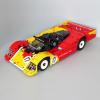
LeTourneau L-2350 wheel loader
Tamas Juhasz posted a topic in LEGO Technic, Mindstorms, Model Team and Scale Modeling
Until the Maz 535 is finished, I'll present some of my MOCs, which are a bit older, but weren't publicized yet. I start with the LeTourneau L-2350 wheel loader, the largest in the world. I made a scale model, with PF IR remote. All functions are motorized: - Drive - Steering - Bucket lifting - Bucket tilting Except drive, everything works via strings and reels. This way it could be built in this scale, there is really a limited space inside, autovalves or servo operated penumatic valves with compressor aren't possible. Weight: 1058 g Top speed: 0,6 km/h Parts count: 680 Video: Pictures: Gallery: With blueprints: Feel free to ask or comment.- 7 replies
-
- LeTourneau L-2350
- LeTourneau
- (and 5 more)
-

[MOC] German Regional-Express with doubledeck coaches and Vectron engi
HoMa posted a topic in LEGO Train Tech
Regional-Express with Bombardier doubledeck coaches and a Siemens Vectron engine Today I am presenting my new train set which is a typical German Regional-Express with doubledeck coaches and a modern electric loco. These trains can be found all over the place in Germany and some years ago I used one of the to comute to work. Since then I had the idea in mind to build a LEGO model of this train. The train consists of 3 Bombardier doubledeck coaches (one with the streamlined end cap) and a modern Siemens Vectron electric engine (you can find the original at https://www.flickr.c...oto/13558726015). The train is build in 7-wide and is powered by Power Functions and two train motors in the bogies of the engine. The Deutsche Bahn company does not use the Vectron engine to push or pull regional trains like this one but I felt that the "grill" structure on the head of the Vectron engine is a nice challenge to be captured in LEGO bricks. The most challenging part was in fact the end cap of one of the doubledeck coaches. Using various curved slopes I ended up in a result which is not perfect, but close to the original shape (see it at https://www.flickr.c...6man/9465049170). At least I've avoided the non-curved 75° slope bricks which would have been to square-edged for the latest version of the end cap. The design phase started with the windows of the upper deck. They have a very iconic bend in the lower half of the window. And I also wanted to have a complete brick-build red-colored frame around the window. The lower part of the window are transparent cheese-corners with the higher side facing outside. The bended part of the window is a SNOT transprent panel which is attached to a Technic hole somewhere inside the coach. The upper red window frame is build using the thin part of a 1x2 - 2x4 bracket element. Unfortunatelly the 1x2 plate of this bracket is facing right inside the interior so I had to modify the minifigs a little bit. The display on each side of the coaches between the lower and upper deck has an offset of 1/2 a plate height and again the thin part of a bracket was used to cover the small gap which is left over when a 1-stud-wide subgroup is build in SNOT wise. Videos I took two short, bad videos just to prove that this train is running. At the end of the "push"-video the power of the batteries died. Pictures You can find more pictures in my Flickr album https://www.flickr.com/photos/holgermatthes/albums/72157662500969610 Enjoy and happy new year to all of you in the Train forum! Holger- 11 replies
-
- 7-wide
- Power Functions
-
(and 1 more)
Tagged with:
-
I have some difficulties in placing this topic in correct section. Should it be Trains? On the other hand it is supposed to work in a modular town, that's why I put it in Town. This is my biggest creation so far. Actually those are two modulars designed to be placed together on a display. The depth is 48 studs instead of regular 32 because of tracks and platform. I decided it was unrealistic to stick to 32 and still have decent building. Anyway, on with presentation :) What I hope is apparent from the picture above is that I incorporated some lights into these structures. The old 9V battery box is in the warehouse and gives power to all six pairs of lights (2x 9V in warehouse and 4x PF in station). There is also old style 9V switch that controls turning lights on and off without the need to reach for the battery box (black switch on the side of the warehouse). Before I show you the warehouse let's have a look at the platform: The warehouse: This is how the electric parts are distributed in the warehouse. You can also see the inside with some pallets and a cupboard for employees. Now, let's have a look at the station building: First - the roof. This is where I put all the lights that go with the station. This is how it looks like from the underside: That's 4 pairs of PF lights, one PF extension cable and one 9V cable to provide easy to disconnect outlet. The station itself has some nice flowers on the front, benches for passengers, some roof over the platform and a phone booth. That's what you could already see from the outside. So let's have a look inside :) There is a bit o a stir at the moment because of some careless passenger. Don't worry - this is being cleaned as we speak :) Looking from the front of the station you have confectionery that sells ice cream too and on the right your typical railway station fast food stand (with microwave in case your yesterday pizza is cold! :D) Looking from the platform side on the left there are some tables belonging to the restaurant, ticket booth and some waiting area. On the right there is an obligatory public toilet :), two gaming machines and luggage deposit lockers. If you wonder how it looks in town - its natural environment - here are just a couple of pictures: Full gallery is available as always on my Bricksafe: http://bricksafe.com...-with-warehouse
-
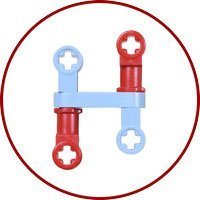
[MOC] Motorized Bus with Instructions
HallBricks posted a topic in LEGO Technic, Mindstorms, Model Team and Scale Modeling
Hi! This is my first (maybe second) post on this forum, but I've been following it for quite a long time now. I started building with Lego Technic about five years ago and now I would like to share with you the video of my latest creation which is this Motorized Bus. This model features: Drive, powered by two L-motors Steering, powered by a Servo Motor Opening front and back doors powered by two M-motors It also has a very detailed fake V6 engine in the back. I started building this model about a year ago. My spare time is rather limited since I'm a student, and I've been working on other projects as well, but there's still a lot of work behind this creation. The doors were the most challenging things to build and it took a very long time to get them right, I've rebuilt that mechanism at least five times. It was also very hard to make a mechanism that would fit under the roof of the bus and not be visible through the windows. Well, now it's finally finished and I'm quite happy with the end result so I hope you like it too and enjoy watching my video!- 49 replies
-
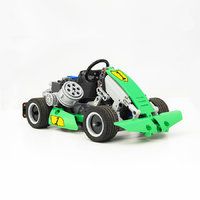
[MOC] Motorizable Skycrane
Anto posted a topic in LEGO Technic, Mindstorms, Model Team and Scale Modeling
Hello ! I have made this skycrane for a contest on TechLUG. The objectives were : Have a mechanism for the rotation of the rotors A host mechanism The helicopter must can catch a container It can have a motorization with a battery box and a M motor for the rotation of the rotors ant the host mechanism We had a maximum of 900 parts I chose to make a gearbox to have the possibility to choose between the rotation of the rotors or the host mechanism. The gearbox is activated by a crank. There is a linear clutch to have progressive acceleration of the rotors and to secure they when the M motor is turning. On these pictures, you can see the rotors mechanism. Here, the pictures of the host mechanism. The clamp is openable by a little mechanism. The motorizatioon can be add in the cab, by removing the interior. It is not the best solution, but there is not space is this helicopter. (You can see it in the video) For the design, I choosed to have a thin fairing. The advantage is the helicopter is more resembling reality ; but there is little place for the mechanic. There are just 2 seats in the cab. A made a detailled turbine. It is imposing, it released to the fairing.- 5 replies
-
- Skycrane
- Motorizable
-
(and 2 more)
Tagged with:
-
Hi everyone! I'm happy to present my newest Lego creation, the completely remote controlled K.I.T.T.! I'm still young, but old enough to know and like Knight Rider. It's the reason, why I recreated K.I.T.T., the main character of the series. Of course with a huge amount of Power Functions! Driving, steering, working scanner and headlights. Six motors, two extenision wires, two pairs of leds, two switches, two IR receivers and an AAA battery box. As many electronic parts, as possible! :D It is my third model at a bigger scale. The building was very interesting. There were a lot of technical challenges with the chassis and the body shaping was difficult, too, because usually I make smaller models. Hope, that I can make more MOCs at similar scales in the future. There are a lot of Lego replicas on the net. For example I found out, that I use the black minifig shields for the wheels. After it I saw, that Firas has already done it! The working scanner and headlights aren't new, too. But! As far as I know, this is the smallest K.I.T.T., which contains these functions! At first please watch the video! Below I tell some things about it, and later there are information about the fuctions and technical detailes! Hope you like it! :) At first I send a huge thank you the three persons, whose names are at the end of the video, for lending me some PF parts, a camera tripod and making the music! It's the first time, that I don't use downloaded music, so I'm very happy! :) Kitt has an enemy, called Karr. Karr was the first car, but he was evil. I built at first Kitt, but later it came into my mind, that it would be more interesting and unusual to build Karr. But almost everyone likes Kitt, and almost noone likes Karr. So finally I decided to put more Kitt scenes into the video and upload the car, as Kitt. I started shooting. I brought out to the street two reflectors, the car and the camera. There are scenes, where you can see two cars together. The truth is that I have only one. After every scenes I exchanged some parts of the body, and continued shooting, without changing the position of the camera. Later I cut the pictures near each other. And it was shocking to watch the scenes on the computer! I thought, that the red light in the dark night will be very impressive and will look very cool. But Karr looks much better. The overall look of him, and the yellow light definitely win against Kitt. I went out again, to make some scenes about Kitt, but the result wasn't better I don't know why, but my camera likes the yellow light better, than the red light. The appearance of Kitt is not so strong, as I thought at first. It is weak But the screenplay allows you to decide, who wins! :) Despite the difficulties, I really liked to make this movie and like the result. Hope, you like it, too! Driving: The car is drived by an L Motor, with a gear ratio 1:1, through a differential. Steering: It is very simple, too. I used a Servo Motor. The other two functions are more interesting. Working headlights: I used two M Motors. If I push the button on the remote control, I start to operate both ones. One of them opens the lights, the other one switches them on. It is impossible to push and release the button fast enough, so I had to use slippery mechanisms. For the opening I used a clutch gear, you can see it on the bottomview picture. But at this level of cramming, there isn't enough place for a clutch gear everywhere, so I found out a new solution. Between the two connectors, there is a small piece of rigid hose. If the switch reaches its end position, the hose can rotate calmly further in one of the connectors, and the mechanism waits my reaction time. Working scanner: Two M Motors again. One of them switches on the light and the other motor, which starts to move the light. The switching mechanism is very similar to one of the pneumatic autovalve. After it changed the position of the PF switch, it rotates further and doesnt cause damage. The construction, which transforms the rotation of the motor to the linear motion of the red light, contains three liftarms. More pictures on my MOCpage! Thanks for watching!
- 24 replies
-
- kitt
- knight rider
-
(and 5 more)
Tagged with:
-
A LEGO Wind Turbine MOC and MOD of the LEGO Vestas Wind Turbine 4999. The original 4999 sets are not only hard to find today but expensive so we worked with what we had in our inventory and bricklinked most of the key structural parts which were the 9 x White Slope, Curved 8 x 6 x 2 Double part #45411 and Curved 8 x 6 x 2 Inverted Double part #45410. Since we were starting from scratch we changed the original scene of the restaurant into a modern seaside house. The modern and modest seaside house features minimal interiors with PF lights for both interior and exterior Here's a full overview video of our LEGO Wind Turbine MOC in detail with all it's Power Functions in action. Enjoy!
- 8 replies
-
- power functions
- renewable energy
-
(and 5 more)
Tagged with:
-

[MOC] RC Articulated Tractor
Anto posted a topic in LEGO Technic, Mindstorms, Model Team and Scale Modeling
Hi everyone ! This is a MOC I made 2 years ago. It is an artulated tractor. It has 2 RC functions : driving by a XL motor and steering by a M motor. There is a 2 speeds gearbox that you can select manually. The articulation allows the 4 wheels still touch the floor. There is a rear lift to hook tools. The PTO can be able and disable by the lever near the seat. Steering : The rear lift : The PTO : (the driving ring catches the bush. The rotation is done trought the rear differential) I tried to do a good design, with a lot of panels. The hood and the seat are red ; the mudguard are black. There is a lot of details like front and rear headlights, exhaust, switches. This tractor has 3 tools. You can see it in the video. :)- 10 replies
-
- Articulated Tractor
- Remote Controlled
-
(and 1 more)
Tagged with:
-
They call those who ride them "rednecks". But while you may ponder whether the setup like this is an overkill or not, a pickup mounted on 10' wheels is a thing to remember no matter the circumstances. Features: ► forward/reverse drive ► separately-driven L6 turbocharged Diesel engine with moving pistons and cooling fan ► steering ► differential and gearing for speed ► simplified cockpit with steering wheel and IR-receiver seats. ► opening cab doors and hood ► exhaust stack ► details such as radiator with grille, front and rear lights, bull bar and reinforced bumpers, roof rack with extra floodlights, rear view mirrors, desert safety flag and fenders 42030 C-model, uses more than 80% of set's parts (loose assumption). 42 studs long and heavy. Despite its weight and only one XL motor as means of propulsion, it has a quite decent speed - it picks up (pun intended) a huge momentum - and an impressive turning radius. Engine is separately powered by L motor. Steering is much like in a video game, where both reverse and brakes are controlled by the same button. Unsuspected bonus: by accident, the bed is perfectly shaped to hold the RC control unit which consists of two RC pilots with a standard RC-car additions. The set's M motor lies dormant, waiting to be used on some extra function I can't currently come up with. It'd be hard to craft the instructions in LDD, but I'll try one day.
-

Yellow Buggy – A tiny and robust RC LEGO car
bartneck posted a topic in LEGO Technic, Mindstorms, Model Team and Scale Modeling
This is a very small, robust, reliable and easy to maintain buggy. It is ideal for letting your kids play with all day. The design goal was to make a robust car as small and simple as possible. This means most of all no suspension system since that would require the use of CV joints. They are known to break and while they work nicely in LEGO super cars that you carefully push around the floor, it does not work with kids trying to race and crash their RC cars. CV joints will break. Of course it is possible to create a LEGO RC car with suspension and even four wheel drive/steering, but then you end up with LEGO’s own RC Crawler. The goal was to keep it small, simple and robust. One of the problems I encountered when letting kids play with the RC cars all day is that the axles in the differential tend to slip and move out. I hence build a differential assembly in which the axles are completely locked in and cannot move. The worst thing that could still happen is that a wheel comes off which is easy to fix. The car uses only one L-Motor and is pretty fast for that. The turning radius is very tight and the car is just fun to drive. The differential makes it perfect to drive around tight corners. The heavy battery pack is right on top of the back axle, giving it the best friction. Well, it does not accelerate like an F1, but it might still make a small difference. Building instructions, LXF, and further information are available. -
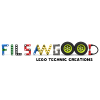
Aircraft Tug XL (Pushback Tow Tug/Tractor Tug)
filsawgood posted a topic in LEGO Technic, Mindstorms, Model Team and Scale Modeling
HI! Today i want to present you my new work - Aircraft Tug XL I started this project a year ago, but bring to mind it succeeded only now. Meet Aircraft Tug XL (Pushback tug/Tractor tug). The model is an extension of the project Aircraft Tug 2014, many of which I am personally not satisfied, and therefore had an idea to build something more functional, large and attractive. Thus was born the Aircraft Tug XL. Machines of this kind is mainly used at airports when towing aircrafts to parking or vice versa - to the runway. I think everyone who has ever been in the large airports, have seen similar tugs. Less a similar technique can be found in seaports or any other freight terminals that require towing heavy loads. This truck has four-wheel drive by two XL motors, independent steering front and rear axle on two servo motors, lifting mechanism cabin, as well as a system of four mechanical jacks driven by two motors L. Full remote management for that answer 3 infrared receiver, and power models provide two large battery pack located on the sides, and of course, he has V10 on board! The functional copy of the tractor completely original machine. The layout of the indoor units I came as close to real. Dimensions: D / W / H 56/27/15 stud. 445/220/120 mm. The model is made of 100% Lego parts except stickers - I made them their own. The basis of design I took the logo of the Khabarovsk airport - in the form of a flying bear. In Russia bears do not just walk down the street with balalykas, but also know how to fly :) I also worked on the detailed cabin from the outside to the inside. Now, in contrast to the previous tractor, the door is open, there is a full salon, which are two fire extinguishers, driver's seat and the passenger, levers, steering wheel, and monitor devices. Tractor turned quite powerful, as you can see by watching video. In practice, it is able to move from his seat and dragged to drag a weight of not less than 6 kg, as long as the batteries have been good charge :) You may see more information and photos on my blog- 17 replies
-
- lego airport
- power functions
-
(and 5 more)
Tagged with:
-

Anyone know anything about suspension for tracked vehicles?
OriolesFan957 posted a topic in LEGO Technic, Mindstorms, Model Team and Scale Modeling
Hi, I am building a tracked all terrain vehicle, wondering if anyone knows about suspension for tracked vehicles. I also need to know how to upload pictures.- 7 replies
-
- Suspension
- Tracked
-
(and 1 more)
Tagged with:
-
My LEGO version of the Baldwin DR-12-8-1500/2 "Centipede". The Centipede was Baldwin Locomotive Work's first attempt at a road diesel locomotive. Its unique feature was 12 axles which made the locomotive looked like a centipede. Unfortunately, it was not reliable and none was saved from the scrap yard. My MOC is powered by LEGO Power Functions. It follows LEGO 6 wide train toy style. It is approx. 60 studs long. Baldwin DR-12-8-1500/2 Centipede by dr_spock_888, on Flickr View from back. The Centipede was original built for passenger service but engine failures left it relegated to freight service. Access to Power Functions AAA battery box. The batteries also adds weight on top of the PF Train motor. Access to engineer in cab for playability (and changing Infrared Receiver channel): It can negiotiate LEGO R40 curves and switches. Although it looks like it is going to take out anything next to the curves. I had to add a lot of articulation to the wheel arrangement. It would look best on the largest ME curved track. I think it is a suitable MOC for all those metal axles I have been making for bogies. There is something interesting about having lots of wheels on equipment.
- 10 replies
-

[HELP] Tips and Pointers for a Tracked Vehicle
OriolesFan957 posted a topic in LEGO Technic, Mindstorms, Model Team and Scale Modeling
Hi, I am working on a new project which is a tracked vehicle, I have started on it and remodeled it 3 times already. I am new to tracked suspension and wanted to incorporate hard shocks. The motor I will be using is the Lego XL motor.- 33 replies
-
- Tracked
- Power Functions
-
(and 1 more)
Tagged with:
-

Making vehicles articulated
OriolesFan957 posted a topic in LEGO Technic, Mindstorms, Model Team and Scale Modeling
Hi, I have recently started a tracked vehicle project. I have made a few other topics about it, building it etc. I was wondering if anyone has made a vehicle then turned around and made it articulated. (Especially tracked) I also need tips on how to do this. Thanks- 18 replies
-
- Tracked
- Articulated
-
(and 2 more)
Tagged with:
-
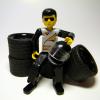
[MOC] Jeep Wrangler
legomarat posted a topic in LEGO Technic, Mindstorms, Model Team and Scale Modeling
RC driving and steering. All wheel drive and Live axle suspension Lifted with Mickey Thompson tires: Internals More on my Flickr Youtube video (I know doesn't work in some countries, you can find it on flickr too)- 21 replies
-
- RC
- Power Functions
-
(and 1 more)
Tagged with:
-
I am looking to build a MOC and want to use drivers either equal in scale the PRR's T1 or larger in scale. I believe BBB XL drivers are still too small, so what is the next best option? Here are a few I was thinking of: 1) Contacting BBB and trying to get a custom set of deivers made. 2) Contacting the custom siderods guy and getting a custom,set of drivers made. 3) Purchasing Lionel T1 wheels and modifying a few bricks to use them. 1 and 2 will be pricey, but it will be closer to true lego. 3 will add weight, improve traction, and reduce derails at high speed, but will need to modify lego brick. Other suggestions welcome!
- 12 replies
-

[WIP] Grave Digger
AxeSlash posted a topic in LEGO Technic, Mindstorms, Model Team and Scale Modeling
I've been lurking here for a while but have never been satisfied with any of my MOCs enough to post them here. The nearest I came was an MLRS that worked well but looked rubbish :P Anyway, I'm in the process of designing a Grave Digger monster truck replica (approx 1:15 ish scale). Features: - 4 wheel drive - 4 wheel steering - Steering modes: 2-wheel, 4-wheel, crab - 4-link, very long travel suspension - Suspension travel is also to scale. Almost. - All motors contained in the chassis (no servo-on-axle affairs) - SBrick control - Tyres from a Tamiya Lunchbox I'm designing this in Sketchup and rendering with the Twilight Render (free) plugin. Note that I've drawn all the pieces myself, and they're all drawn to have a low polygon count so that my machine doesn't croak to a halt. Some of the pieces aren't very accurate atm (e.g. the XL motors). So far, I think I've got the chassis designed: And here's a couple of closeups: Issues I can foresee so far: - Friction from so many knob wheels - Bump steer (but I don't want to sacrifice suspension travel by putting the servo on the axle) - Not sure whether having the steering upside down like that will have any negative effects. - Not sure if I can get all of the parts in green that I want Can anyone see any other potential issues with this design (before I start putting in BL orders)? Thanks- 35 replies
-
- monster truck
- power functions
-
(and 2 more)
Tagged with:
-
Hello, I'm happy to introduce you to my modular garage with power functions and pneumatics: This modular has the following components: 1x Rechargeable battery box (8878) 1x M motor 1x air tank 1x manometer 2x small pumps (6L) 2x small pneumatic cylinders 2x medium pneumatic cylinders with square base Approximately 1,5m of pneumatic tubes (I didn't count, maybe there's more) I always wanted to mix technic and regular system bricks and I already did so with my Ice Cream Parlor (http://www.eurobrick...opic=111129&hl=). Now, with my third modular, it was time to introduce pneumatics! :D This is the coolest part of LEGO for me and to increase the cool factor I have used manometer as well :D This building's purpose is mostly to have fun, so I didn't care that much for the fact that gigantic manometer on top of the building is rather rare sight in real life ;) I simply always wanted to have one and observe the changing pressure as I play around with my model and here it is! Anyway, we have here compressor that powers cylinders that open the doors (2 small cylinders) and rise and lower the car lift (2 medium w/ square base). The list accepts cars up to 7 wide and has a lot of lifting power. You can remove all three sections of the roof for easy access. Here is full gallery on Bricksafe: http://bricksafe.com...modular-garage# And here is movie on youtube: Enjoy!
- 17 replies
-

Ultra Small Forklift - Muravi
mahjqa posted a topic in LEGO Technic, Mindstorms, Model Team and Scale Modeling
So I prefer to build small. I managed to miniaturize all the functionality of a standard forklift (driving, lifting, tilting) into a chassis only 11 studs wide. One of the advantages this offered me (among better strength, speed and maneuverability) is that I was able to build an entire warehouse to muck about in. This wasn't always the plan. I thought I'd just build two or three containers to show off its functionality, and that would be it. Then, the Android Sbrick app crashed and burned (or at least, it did on my phone) and it took two months for them to update the thing into relative functionality again. So I had plenty of time to build some scenery. For the enthusiasts; I've uploaded a LXF file to Vayamenda.com so you can tinker with it. (By the way, if you're a person who has built a forklift, could you link me to a picture of your forklift in this view? https://www.flickr.com/photos/28134808@N02/26063611241/ I'm very curious to see how it's scaled relative to other people's MOCs.)- 70 replies
-
- sbrick
- power functions
-
(and 1 more)
Tagged with:
-

42005 Monster Truck - Motorized and RC
Splat posted a topic in LEGO Technic, Mindstorms, Model Team and Scale Modeling
I would like to present my motorized and remote controlled (IR) version of this year's Monster Truck set (42005). My first goal was to keep the overall look and dimensions the same as the official model: The wheels, chassis and body are in the same positions, Only the axles, inner workings, and battery box have changed. My second goal was to somehow get the vehicle to have both steering and 4WD: As you can see above, I achieved the steering by making the entire front and rear axles turn via the use of gear racks and 6L links, while the drive goes through the ball joints, differentials, and portal hubs. Steering is handled by a PF Servo Motor, while drive is handled by a PF L motor. It is powered by a PF Rechargeable Battery, and a PF IR Receiver V2. My third goal was to increase the vehicles clearance as much as possible: And my last goal was to maintain a good amount of articulation: I had to modify the suspension attachment to allow an extra degree of movement to allow the suspension to operate smoothly. It runs quite well over small obstacles, however it is very top-heavy, so it does roll over quite easily. This isn't helped by the fact that as it turns, it leans outwards (opposite to how a skateboard works). Here are the parts (guts) that I had to remove from the original model: All pictures can be clicked on for larger versions at Brickshelf (once moderated). Here are some more pics: And last but not least, here is a link to the LDraw file: 42005_motorized_monster_truck.mpd Overall I am pleased that I was able to get this motorized given that there was only a small space to work with, and the model is very sturdy. I hope you like my motorized and RC 42005 Monster Truck. Any and all feedback/constructive criticism welcome. Edit: I have submitted this MOC to Rebrickable. Edit: I have created a quick video: Sorry about the audio quality - it was a very windy day!- 21 replies
-

LDD Lego Ideas MOC: Amtrak Amfleet I Series Passenger Cars (5 Pictures
JesusIsLord posted a topic in LEGO Train Tech
Taking a break from my High Speed Train Project, I decided to once again attempt an Amfleet car, easier said than done due to the curved design of the car, I also plan on building a AEM-7 to go with it and upload the locomotive and passenger car to Lego Ideas. The carriage is 8 studs wide, I attempted to make it 6 studs wide since it's going on Lego Ideas, but because of the way the body of the passenger car curves inwards on the bottom (and top), it looked horrible being 6 studs wide. The car contains 22 seats and a bathroom (inspired by the Horizon Express bathroom), opening external doors, I have not built internal doors (yet), the real train has sliding doors, but that is not possible (at least for me, I'm sure someone else could do it) with LEGO, currently the passenger car contains 662 pieces, but that number will be increased when I add opening internal doors. The bogies are able to swivel 360 degrees which will allow them to turn with ease on the tight turns of standard LEGO track. Please also check out Shupp's Amtrak AEM-7 and Amfleet Coach from 2011. Thanks for reading, God Bless Christ be with you all .lxf file: http://www.mediafire...mp15/amtrak.lxf





